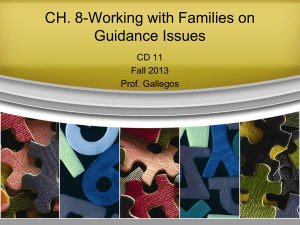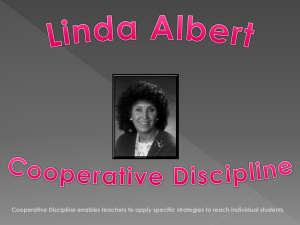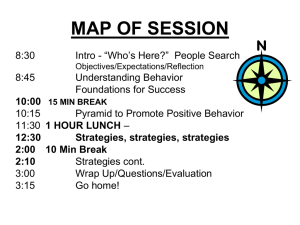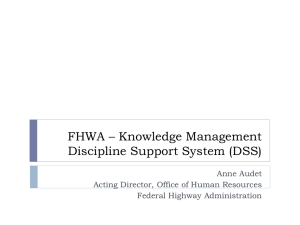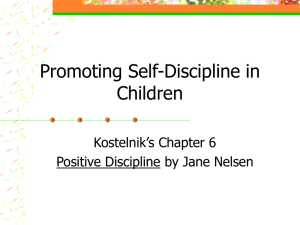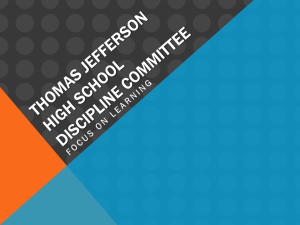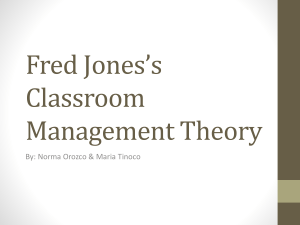Beyond Discipline
advertisement
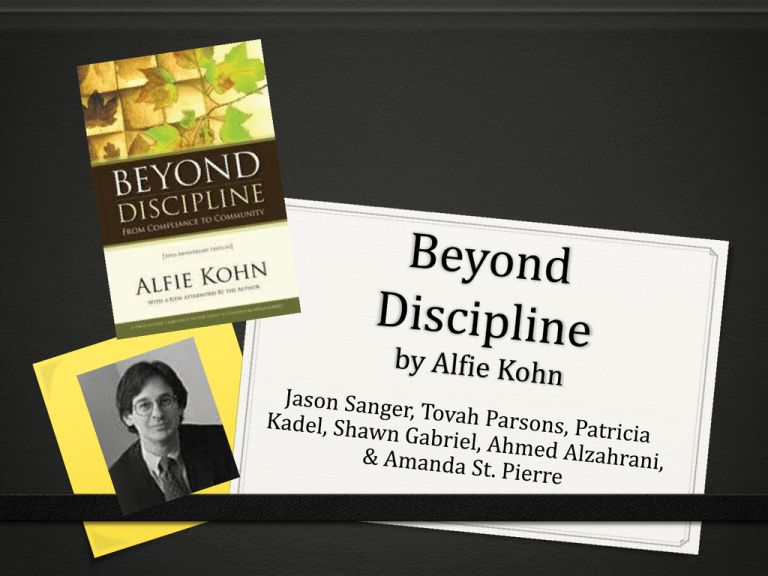
Qualities of Successful Classroom Management 0 The teacher is the control of behavior 0 Teachers who are successful: 0 Do not concentrate on discipline 0 Prevent problems by keeping students engaged Discipline 0 Discipline is driven by negative beliefs about children 0 The objective of many discipline programs is to get children to comply with adults. 0 How we manage our classrooms has everything to do with what we believe about people. Hidden Premises “If the teacher isn’t in control of the classroom, the most likely result is chaos.” “Children need to be told exactly what adults expect of them, as well as what will happen if they don’t do what they’re told.” “You need to give positive reinforcement to a child who does something nice if you want him to keep acting that way.” “At the heart of moral education is the need to help people control their impulses.” Basic Human Needs 0 Autonomy – experiencing self-motivation, feeling empowered, not a victim of circumstance or environment 0 Relatedness – the need to feel connected, loved and affirmed. 0 Competence – learning new things and being able to apply them. Questions to Drive our Discipline Policies 0 What do children require in order to flourish? 0 How can we provide those things? Instead of: How can we make them do what we want them to do? We need to guide our students toward developing personal and social skills, just as we would teach them about any subject in school. BLAMING THE KIDS 0 The problem always rests with the child who doesn’t do what he is asked, never with what he has been asked to do. 0 Is the adults request reasonable? 0 When students are “off task” our first response should be to ask, “What’s the task?” 0 To focus on discipline is to ignore the real problem: We will never be able to get students( or anyone else) to be in good order if, day after day, we try to force them to do what they do not find satisfying. BRIBES AND THREATS 0 COERSION- Without regard to motive or context, past events or future implications, the adult simply forces the child to act (or stop acting) in a certain way. 0 PUNISHMENT- Deliberately chosen to be unpleasant, and must be intended to change the student’s future behavior. 0 REWARDS- Do this, and you’ll get that. Do rewards work? Yes, for short term compliance. 0 Why do we punish?- It’s quick and easy. Works to get temporary compliance. It’s familiar to us. It’s expected. Gives us control. If we don’t punish, students might think they “got away with it.” PUNISHMENT LITE: “CONSEQUENCE” AND PSEUDOCHOICE 0 Punishment vs. Natural Consequences. 0 PSEUDOCHOICE1. Obey or Suffer- Do what I tell you to do or I’m going to punish you. 2. You Punished Yourself- If a student acts out they are also choosing the natural consequence. 3. Choose… and Suffer- Students are encouraged to make decisions so they will suffer from their poor choice. SUMMARY 0 It’s easier to blame the child for misbehaving or acting out. 0 Getting short term compliance will not solve the issue. 0 Punishment is easy to use and that’s why we use it. 0 Do we really give students a choice? Effective...But at What? "Withitness" Kounin 1970: The teacher not only was attentive to what students were doing, but let them know she knew what was going on. To be effective… to Kounin it meant.. Sit Down and Shut Up !! 0 Why does everyone think that the teacher should be in control of the classroom? 0 Why do we have to make students comply? Be Seated and Refrain from Talking! 0 “The more voice and choice students have, the more cooperative and responsible they will act and feel”. 0 The New Disciplines are just as much about getting compliance as is the more traditional approach. 0 "get the trains to run on time in the classroom, never mind whom they run over.” The Problem with Compliance 0 Teachers want students to be good people, not necessarily good learners 0 Long-term goals 0 “Desirable outcomes are harder to achieve if we rely on bribes and threat”. 0 "The more we 'manage' students' behavior and try to make them do what we say, the more difficult it is for them to become morally sophisticated people who think for themselves and care about others." Making Moral Meaning 0 The constructivist model of learning challenges the central metaphors that so often drive instruction 0 The only way to help students become ethical people is to have them construct moral meaning 0 Maximize the opportunity for students to make choices and to discover and learn for themselves 0 Create a caring community in the classrooms that students have the opportunity to do these things together Behaviors v. People 0 The developer of one New Discipline program has described its goal as getting students to choose appropriate behaviors. 0 Discipline Programs can change behavior, but they cannot help people to grow Beyond Rules 0 The problems with rules are that they: Turn kids into lawyers that are just looking for loopholes. Turn teachers into police officers, a role utterly at odds with being facilitators of learning. Often include punishments for breaking them. 0 To avoid this: Have the students create the rules Think about how everyone should treat each other The Value of Conflict 0 Kohn says that it is more important for students to wrestle with dilemmas, clash with others ideas and take others needs into account than to follow sets of rules. 0 Kohn says that conflict presents golden opportunities for learning and therefore should not be suppressed. 0 Even hurtful conflicts need to be resolved rather than pushed aside. Conclusion 0 Many teachers are afraid that they will lose control of the class. 0 Effective teachers use collaborative problem solving instead of coercive control 0 Education must be reformed so that classrooms take on the nature of communities. 0 Teachers who wish to move beyond discipline must do three things: provide an engaging curriculum based on student interests, develop a sense of community and draw students into meaningful decision-making Why should students have a say in making real decisions? Alfie Kohn tells a tale of two teachers. 0 Teacher #1 made all the rules insisting that students obey without question. 0 Teacher #2 stopped commanding and started LISTENING. She found that students learned to make good choices by creating the options for themselves, instead of following directions. 0 “The construction of meaning is an active process” Why should students have a say in making real decisions? 0 “Choice promotes compliance and minimizes behavior” – p 81 0 When teachers change their questions to begin with, “How do you think we can …” and “How many ways can we …”, this enables students to develop their problem-solving abilities and experience a sense of community How do we help students develop thinking beyond self-discipline? 0 Self-discipline means setting your own intrinsic expectations and meeting them 0 Beyond self-discipline is when children possess the skills and the inclination to solve problems autonomously and together. 0 “Anyone who truly values democratic ideals would presumably want to maximize children’s experiences with choice and negotiation.” – p 85 What are the structural guidelines when students are in control? When students are asked to invent a system that address everyone’s concerns, some criteria apply. 0 Purpose: What is reason for a restriction? 0 Restrictiveness: What is the need that it meets? 0 Flexibility: Time schedules and tasks must have room to adapt to immediate needs of individuals and the group 0 Developmental appropriateness: When students establish expectations for their community, they must consider if it applies to all ages or all individuals. What are the structural guidelines when students are in control? 0 Presentation style: When students negotiate for change, the way they introduce their ideas can make a difference on the response of others. 0 Student Involvement: The input in community building conversations, interactions and tasks directly relates to their sense of control. To Meet Needs, We Need to Meet: When, Where & How do we make Meetings Work? 0 Take time CONSISTENTLY for meetings to make academic time more efficient. 0 Clarify the purpose of meetings: to meet needs and reflect on what is working and what is not working that needs changing 0 Plan together any decision that influences the group, which may involve voting. 0 Share successes that contribute to community. Reflections on Decision Making: What to Expect in Transition Children who have been tightly controlled may need time to rebuild trust in themselves and you. 0 They may exhibit disturbing, destructive, or damaging behavior or refuse to participate. 0 They may parrot what they think you want or silently nod approval without contributing. 0 They need to test the depth of freedom and how the response will be to their behavior. Reflections on Decision Making: What to Expect in Transition Trust is built on several basic habits: 0 LISTEN to students’ needs and their ideas how to meet them with affirmative responses. 0 Be CONSISTENT in giving students the option to create their own solutions to problems. 0 Provide resources and support for their ideas. 0 Show appreciation for student models that build student leadership and community. It is not management techniques that make the difference, but rather a way of thinking on the part of the teacher. The perspective is that we are the caretakers of the learning environment that nourishes students’ natural curiosity, helping them develop their problem-solving abilities and experience a positive sense of community. What is community? A place where students feel: 0 Valued 0 Respected 0 cared for 0 Encouraged 0 Safe (physically and emotionally) 0 They matter to everyone There is a sense of unity and pride for all involved in the community. Why community? The Child Development Project found: 0 Promotes social, moral and intellectual development 0 Stronger community feeling = more students report liking school and learning 0 Positive effects are greatest in students with a low socioeconomic status Overall-if you want kids to do well in school, you have to help them develop an environment that helps them feel good about school and their classmates. Community misconceptions 0 Students lose their identity and conform 0 Building a community is simply about being nice 0 Students will become compliant 0 The teacher alone creates community for the students Community Building Prerequisites 0 Time 0 It takes time for the students to get to know one another in a community context 0 Group Size 0 The classroom is a good size, too large and you may need subcommunities 0 Teacher 0 Needs to be a part of the adult community at the school Community Building Strategies 0 Relationships with adults 0 Important that students see the teacher as a human 0 Show them that you genuinely care 0 Be vulnerable 0 Admit when you are wrong 0 Remember details about their lives 0 Authentic responses to their questions 0 Model positive interactions for them Community Building Strategies 0 Connections between students 0 Use activities to get them connected 0 Interviews and introductions 0 Give them the opportunity to share their thoughts and feelings 0 Give them the opportunity to view things from the perspective of others These kinds of activities help them feel more connected to others and to feel more understood in the community. Community Building Strategies 0 Classwide and schoolwide activities 0 Whole group collaboration activities 0 Class mural, collage, quilt 0 Class meetings to practice community together 0 Sub-communities if necessary Community Building Strategies 0 Using academic instruction 0 Relate community to what is going on in the classroom: homework, projects, reports, etc. 0 Build discussion time into your instruction as an opportunity to practice community 0 Cooperative learning so students can learn and grow from one another 0 Tie curriculum back to the classroom community Final Thoughts On Community 0 Powerful classroom community can help students make more positive associations about school. 0 Community helps us move beyond discipline and nurture students more effectively. 0 You must involve students in building the community-it is not effective if you impose it on them. #1 – Build & Maintain Positive Relationships 0 It's important for students to trust their teacher, to know he/she respects them and to feel safe in speaking their minds with him/her. 0 Nowhere is such a relationship more vital than in the case of a student who has done something wrong and feels angry or defensive. 0 Students must feel accepted by adults. #2 – Skill Set 0 Teachers may need to help their students learn to listen carefully, calm themselves, generate suggestions, imagine someone else's point of view, and so on. 0 Children should have the chance to work on these skills from the time they are very young. Like us, they need guidance and practice to get better. #3 - Diagnosis 0 The teacher’s role in dealing with an unpleasant situation begins with the need to diagnose what has happened and why. 0 Teachers sometimes need to play detective and try to figure out what is going on, or how to interpret what the child is telling them. 0 Punishments and rewards are unproductive in part because they ignore the underlying reasons for a given behavior. #4 – Question Practices 0 Must be willing to look beyond the concrete situation in front of us. 0 Is the student really the problem? 0 Does my teaching engage them? #5 – Maximize Student Involvement 0 Expand the role students have in making decisions about the classroom environment. 0 “Talk less, ask more.” 0 Involve students in figuring out what to do when something goes wrong, and give them responsibility for implementing a solution. #6 – Construct an Authentic Solution 0 Asking students to come up with solutions will not get us very far if they feel obliged to cough up explanations, suggestions, or apologies on demand. 0 The questions teachers ask them must be open-ended, with students encouraged to explore possibilities and reflect on their own motives. #7 – Assist Students In Making Restitutions 0 A reasonable follow-up to a destructive action may be to try to restore, replace, repair, clean up, or apologize, as the situation may dictate. #8 – Re-Evaluate Plans 0 Determine if a plan worked, whether the problem got solved, whether additional or entirely new strategies may now be needed. #9 - Flexibility 0 “Doing to” (punitive) responses can be scripted, but "working with" responses often have to be improvised. 0 Example: Difficulty getting a student to talk openly about what is bothering him/her and it will make more sense to drop him/her a note and invite a written response. #10 – Minimize Punitive Impacts 0 Example: If a problem behavior is persistent and the teacher asks the student to leave the classroom, the teacher's tone should be warm and regretful, and he/she should express confidence that the two of them can eventually solve the problem together. 0 Control is a last-resort strategy to be used reluctantly and rarely. From a High School Teacher: 0 “If I just kick kids out of class, I "don't tolerate" their actions, but neither do I educate them or their classmates. And it works about as well as stamping out a few ants. I prepare them for repressive solutions where misbehavior is temporarily contained by an outside authority, not really addressed. Sometimes I am forced to that position, but I try not to be.”
